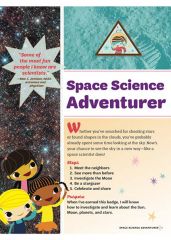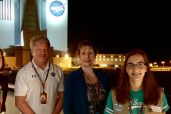GSUSA recently announced its release of 30 new badges for girls ages 5–18 focused on science, technology, engineering, and math (STEM)
August 14, 2018 (Mountain View, CA)—The SETI Institute and Girl Scouts of the USA (GSUSA) have come together to celebrate the release of new Girl Scout Space Science badges during the launch of NASA’s Parker Solar Probe, the first-ever mission to “touch” the Sun.
GSUSA recently announced its release of 30 new badges for girls ages 5–18 focused on science, technology, engineering, and math (STEM); the outdoors; and life skills. Among the new badges are Space Science badges for Girl Scout Daisies (Grades K-1), Brownies (Grades 2-3), and Juniors (Grade 4-5). Space Science badges for Cadettes (Grades 6-8), Seniors (Grades 9-10), and Ambassadors (Grades 11-12) will be released next year.
Funded by NASA’s Science Mission Directorate and led by the SETI Institute, each badge was developed by GSUSA in collaboration with the SETI Institute’s subject matter expert partners from the University of Arizona, ARIES Scientific, and the Astronomical Society of the Pacific, as well as Girl Scouts of Northern California. To guarantee that only the highest-quality content made its way to girls, GSUSA led three rounds of national pilot and field testing to ensure the activities are fun, age-appropriate, and achieve the program’s learning outcomes.
Daisies who earn the Space Science Explorer badge observe the Sun, Moon and sky. Brownies who pursue the Space Science Adventurer badge dig into the Solar System, Moon phases, constellations, and share their findings. And Juniors who tackle the Space Science Investigator badge explore the planets, celestial motion, the three-dimensional nature of a constellation and develop models that explain the size and scale of our Solar System.
The Space Science badge development is part of the SETI Institute’s and GSUSA’s broader “Reaching for the Stars: NASA Science for Girl Scouts” program. Other program features include train-the-trainer workshops for girls and volunteers, including the Astronomy Camp for Leaders at the University of Arizona; the Girl Scout Astronomy Club training at NASA’s Goddard Space Flight Center for girls, volunteers, and amateur astronomers; and, most recently, Girl Scouts’ Astronomy Adventure Destination at the University of Oregon’s Pine Mountain Observatory, where campers learned how to operate telescopes, participated in solar and dark-sky observations, and other space science activities.
Exposing girls to STEM at a young age is vital to developing their interest in STEM careers, and is great way to foster a lifetime love of the cosmos.
“Space exploration and astronomy are exciting topics for teaching science and promoting STEM. We are thrilled to be partnering with GSUSA on this powerful NASA-funded STEM initiative,” said Bill Diamond, CEO of the SETI Institute. “The prospect of influencing the education and career choices of millions of young girls over the coming years makes this one of the Institute’s most compelling programs ever!”
“Girl Scouts is excited to celebrate the release of these new Space Science badges with SETI and NASA,” said Girl Scouts of the USA CEO Sylvia Acevedo. “As a rocket scientist myself, I first developed my passion for space and astronomy on a camping trip with my Girl Scout troop. It’s so exciting to think how earning these badges will expose the next generation of girls to new passions, new pursuits, and new ways of thinking about the cosmos.”
Booklets that detail the requirements for the Space Science Explorer, Space Science Adventurer, and Space Science Investigator badges are now available online at girlscouts.org and will be in Girl Scout council stores mid-August.
Harman and Diamond witnessed the NASA Parker Solar Probe launch together on August 12 in Cape Canaveral, Florida. They were joined by Denise Ryan, Federal Relations Manager for GSUSA who escorted two Girl Scouts, and co-investigator Lou Mayo of ARIES Scientific.
We're Girl Scouts of the USA
We're 2.6 million strong—1.8 million girls and 800,000 adults who believe in the power of every G.I.R.L. (Go-getter, Innovator, Risk-taker, Leader)™ to change the world. Our extraordinary journey began more than 100 years ago with the original G.I.R.L., Juliette Gordon “Daisy” Low. On March 12, 1912, in Savannah, Georgia, she organized the very first Girl Scout troop, and every year since, we’ve honored her vision and legacy, building girls of courage, confidence, and character who make the world a better place. We’re the preeminent leadership development organization for girls. And with programs from coast to coast and across the globe, Girl Scouts offers every girl a chance to practice a lifetime of leadership, adventure, and success. To volunteer, reconnect, donate, or join, visit www.girlscouts.org.
About the SETI Institute
Founded in 1984, the SETI Institute is a non-profit, multi-disciplinary research and education organization whose mission is to lead humanity’s quest to understand the origins and prevalence of life and intelligence in the Universe and to share that knowledge with the world. Our research encompasses the physical and biological sciences and leverages expertise in data analytics, machine learning and advanced signal detection technologies. The SETI Institute is a distinguished research partner for industry, academia and government agencies, including NASA and NSF.
Contact information
Rebecca McDonald
Director of Communications
SETI Institute
189 Bernardo Ave., Suite 200
Mountain View, CA 94043
rmcdonald@seti.org
www.seti.org







